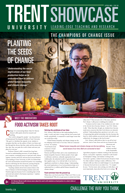 Trent University Professor Concurs with Mercury Contamination WarningsFOR IMMEDIATE RELEASE Research Conducted by Professor Holger Hintelmann Aims to Identify Mercury Sources in Environment Thursday, March 8, 2007, Peterborough Trent University Professor Holger Hintelmann agrees with the findings published today in the internationally respected science journal Ambio that mercury levels in the environment are posing serious health risks worldwide. “There is no question that the amount of mercury bioaccumulating in the environment has reached levels of great concern in many parts of the world, especially in fish and around industrial mining sites,” said Prof. Hintelmann, chair of the Chemistry Department at Trent University. However, Prof. Hintelmann stresses that fish have positive nutritional effects so it should still be considered a valuable and important food source around the globe. “The trick is to choose fish to eat that are low enough in mercury so that they are safe for consumption. Those fish exist almost everywhere, and it is therefore important to educate fish-eating populations to select ‘safe’ fish. Typically, older fish and ‘fish that eat other fish’ show elevated mercury levels and should be consumed less frequently or not at all.” Entitled “The Madison Declaration on Mercury Pollution”, today’s report presents 33 principal findings from five synthesis papers prepared by the world’s leading mercury scientists. This declaration and supporting papers were developed last August during the eighth annual Conference on Mercury as a Global Pollutant held in Madison, Wisconsin. Prof. Hintelmann attended this conference and endorsed the declaration, which stated several major findings, including the following:
Prof. Hintelmann is studying the biogeochemical factors that promote or hinder the formation of toxic methylmercury in the environment. Through his research, Prof. Hintelmann has also determined that various sources of mercury each has a unique “isotope fingerprint”, enabling scientists to track whether mercury contamination is the result of natural or industrial processes. “The question we are looking at now is to determine how much mercury is naturally occurring vs. the result of human activities. This data will help inform policy makers when setting mercury reduction targets for industries,” explained Prof. Hintelmann. Prof. Hintelmann recently completed his Natural Sciences and Engineering Research Council (NSERC) Industrial Junior Research Chair in environmental modeling and received a Premier’s Research Excellent Award (Ontario). He is internationally recognized as a leader in applying stable mercury isotopes in environmental studies. He developed a variety of methods to analyze environmental samples for their contents of mercury species using Inductively Coupled Plasma Mass Spectrometry (ICP-MS). Prof. Hintelmann was also instrumental in establishing the METAALICUS (Mercury Experiment To Assess Atmospheric Loading in Canada and the US) project (still underway at the Experimental Lakes Area in northwestern Ontario) that investigates the relationship between atmospheric mercury levels and mercury in fish. The METAALICUS project makes prominent use of stable mercury isotopes as tracers to establish such a link. He is responsible in part for the project design of this study that includes as many as 10 different research teams and 12 principal investigators, all of them leading mercury researchers from Canada and the US. -30- For further information, please contact: |
































